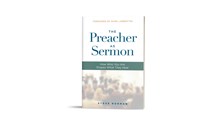
PreachingToday.com: A host of books and articles have been published recently telling us that the key to reaching today's congregations is to use narrative, storytelling. How can a preacher tell a story well?
Kevin Miller: I actually was a writer first and a preacher more recently. I'm not gifted with natural dramatic flair, but I found that a lot of the skills I learned as a writer transferred beautifully into the pulpit, and I could use the things that make a story work in print. Often I can use those same principles as a preacher, and I get better results.
What types of principles?
Well, one thing I've taught writers for years in workshops and now I use in my own preaching is a system called 3-D storytelling. It's a simple way to remember three things that help make your stories more vivid, and they all start with D.
What's the first D?
The first thing that helps improve your stories is details, concrete details. As a writer you're always asking yourself, How can I describe this scene in a way that people can see it? You can also describe the sounds involved.
For example, let's say I'm writing a scene and it's happening at the ocean. I'm going to describe the sound of the waves crashing on the shore. I'm going to describe the squawk of gulls. I'm going to talk about things you can see, like circling gulls in the sky or mounds of seaweed along the shoreline. And so when I tell a story in the pulpit, I want to do the same thing. I want to select some key details that help people visualize themselves in that situation.
It should be concrete. It should be something that everyone in the audience knows. It adds that sense of a specific, concrete, immediate item they can see, hear, taste, or touch.
Bill Hybels did a sermon a number of years ago called " The Character Question. " He compared leaders starting ministry to cars starting the Indianapolis 500. Now, a lot of preachers, because we're in a hurry and we don't have time to prepare, would just say something like, " You know, Christian leaders are a lot like Indianapolis cars. They've been dropping out of the race. " And that would be a pretty interesting analogy. But hear how much better it is when you use specific details. Here's how Bill started his sermon, and he preached this on Indianapolis weekend, so it was well-timed. He said:
If it hasn't started already, in just a short period of time the green flag will drop at the Indianapolis Speedway signaling the start of the world's most celebrated auto race. Thirty-three gleaming, low-slung, turbo-charged weapons will shoot out of the fourth turn and scream through the starting gate at almost 200 miles an hour.
Now, did you hear all the concrete details Bill put in there?
Absolutely. It was just like being right there. You could feel the energy.
Yes. In fact I don't know whether he's been to Indy or not, but he knows there are 33 cars in the race. He knows they start out of the fourth turn. He knows they go 200 miles an hour. And those specific, concrete details make the story much more vivid for the listener.
So the first thing you want to remember is details.
Is there such a thing as a detail you don't want to use? How do you know when it's a bad detail or unnecessary?
You can bog down a story with too many details, and the way you know the difference is to ask, What is the main point of the story? Does this detail help bring forward the main point of the story? Does it show an aspect of that person's character that's important to the story?
For example, if I want to talk about someone who gave so sacrificially that they didn't have enough money for themselves, I might point out that the shirt they were wearing was worn at the cuffs and elbows. But I wouldn't include that detail if I was telling a story that had nothing to do with his not having enough money for new clothes. So you want to pick the detail that brings out the point you're trying to make.
I've got an illustration. I've picked the poignant details, those that enable me to see it before my eyes. How else can I enhance this story?
The second thing I encourage writers and preachers to do to bring stories alive is to use dialogue. That's the second D — details, dialogue. You want to bring out what the main character is thinking, because when you use dialogue it's as though you're letting listeners eavesdrop on the conversation. And people naturally like to eavesdrop on interesting conversations. They do it in restaurants. They do it at Starbucks. So when you tell a story that uses the actual words of the characters in dialogue, it makes everybody else want to listen in. Let me give you an example of that.
Recently on Preaching Today there was a sermon by Josef Tson, who was a pastor in Romania and was persecuted by the Communist regime there. He tells about a time when he was being interrogated every day, and the way he tells the story is powerful because he uses the actual words of the interrogator, and then he gives you his actual words in response. Then as the story moves on, he has an encounter with Jesus, and rather than just saying, " During prayer I had this sense that Jesus was present to me, " he gives you the actual words he believed Jesus was speaking to him at that time. I know a lot of preachers wouldn't want to go there, but it's compelling and powerful to hear those actual words.
I have a clip here and I'd like to play this story so you can hear how Josef Tson uses dialogue to help bring the story alive.
I was interrogated for six months, having to go every day for eight to ten hours Monday through Friday. After about three months, the interrogator told me they were muckraking. You go through the life of a person and find everything dirty there. " We have many ugly things from your past, and we are going to spread them to all the churches. Your Baptists will come to smash your windows. "
I became pale. Power left me. I started to tremble because there was dirt in my life — my past, those years when I was away from the Lord. He looked at me and was afraid I had a heart attack. It was eight o'clock in the evening, and he called but couldn't find a car available [to take me home]. He said, " I don't want you to die here. " He took me into the street, stopped a taxi, told the driver my address, and said, " Take him home. " I went home, and for two days I couldn't walk. I was crushed.
That Saturday morning, in my morning devotion Jesus was in front of me and said, " Josef, let me tell you how you imagined your martyrdom, going with your cross to be crucified but passing among two rows of Christians applauding. 'Bravo, Josef!' But what if I make those brothers and sisters of yours as you pass with your cross stoop down, take mud, and throw it on you and your cross? Will you accept a cross with mud on it? "
" Lord, even this is from you. Then I accept it. "
It came like lightning. It hit me in the head and went through my legs, and at that moment I was able to stand up. When they called me back the following week and the man started gently to tell me something, I snapped [a response]. With each sentence he said, I retorted. At one point he stopped and said, " Mr. Tson, who visited you this weekend? I have in front of me a different person than the one who left here. Somebody came and changed you completely. I have to know who came and visited you. "
" Jesus visited me and made me ready for the battle again, and I accepted even the mud as coming from him. "
I want to reflect on what made that story especially powerful. Not only was it on a very emotionally compelling topic, namely, persecution, but when he talked about the interrogator, he used the actual words: " Mr. Tson, who visited you this weekend? " You can get a sense for that character. And even when he talked about his time of prayer to the Lord Jesus, he used exact words: " Jesus was in front of me and said, 'Josef, let me tell you how you imagined your martyrdom.' " It's very compelling. You want to listen in on that conversation.
And so dialogue is critical to a vital story.
It sounds to me also that when you have that opportunity to retell the dialogue, you can move the inflection of your voice to create the emotion inherent in the words.
Yes. And a lot of people when they'll tell a story won't use what's called direct address, the words themselves; they'll use indirect address. For example, let's take that story Josef Tson used. Instead of using Jesus' exact words they might say something like, " And during prayer I had a sense that I was imagining my martyrdom this way, and I really should be seeing it another way. " Well, that could be compelling, but it's much richer when you give the actual words of the characters in the story.
Now I should mention that, as with details, it's possible to overdo dialogue. You want to use dialogue when it reveals something of who that character is, what they're thinking and feeling. You don't want to use dialogue to communicate something that is a basic fact like " the sun was up " or " it was ten o'clock. " You don't need to put that in the direct words of characters.
What is the third D?
I'm going to use a word you may not have heard since college English class, and that is denouement, which means the ending, the conclusion, the wrapping up of all the elements in the story neatly at the end. And so the third D I use to help people with stories is delayed denouement. And what I mean by that is, leave the ending for the ending.
Now you might think, That is basic. Who would violate that principle? But sometimes when we're preaching, without meaning to, we tip off what's going to happen in the story.
For example, let's say I want to tell a story about human folly to demonstrate the waywardness of people apart from God's Spirit, and to illustrate that I want to use a story from my college days. I could start that story by saying, " Let me tell you about the time the dean kicked me out of college and suspended me for three days because of what I had done. " But as I'm setting up that story, I've already told my listeners the punch line.
The punch line is " The dean kicked me out of college because of my foolish ways. " It's much better for me to say, " It was 2 A.M., and there I was hanging on the ivy, clinging to the downspout of Houser dormitory as I got ready to make my raid. " Well, now everybody is listening. They want to hear what happens in the story, and eventually of course will come the punch line: " The dean suspended me, and I learned a lesson about the perils of human folly. " But sometimes, because we're focused on the point the illustration makes, we tip off listeners where it's going to go.
In writing we often create a delay by telling the beginning of the story in the introduction and waiting until the very end to give the conclusion. Do you do that in preaching, too?
I've heard people start a sermon with an illustration of a person who is facing a dilemma, and you don't find out how it's resolved until the end of the sermon. Joseph Stowell at Moody Bible Institute recently gave a sermon in which he talked about how we have to follow Christ even though it may cost us comfort. In the opening of that message he talked about a man in his congregation who had a highly placed job with a cable company, and he said to Dr. Stowell, " I don't know whether as a Christian I can continue to work here, because our cable system puts out channels I think are completely antithetical to my Christian faith. And I'm not sure what I should do about that. " Well, then Dr. Stowell carried on with the message. He left the congregation with that tension, while the story remained unresolved. Then at the end of the message he came back around and told what happened to that person, what decisions he made. It's an effective technique.
If you do that, though, it needs to be a compelling enough story that people will remember it by the time you get to the end of your message, so they're still with you.
Are there any exceptions or variations to using this technique?
I think all stories will work better with the right details, the right dialogue, and a delayed denouement. The only thing I would say is that sometimes it takes a little practice to determine exactly how many details to use and where to put them. One of the reasons I listen to Preaching Today is because I like to listen to people who are skilled, and most of the people on Preaching Today do this well. Everyone will have their own approach to storytelling, but the more you use these principles the better off it will be.
Why is it better off? How do these principles help?
In storytelling, you want people to imagine they're in that scene, and when you use details where they can see the room and they can see the bare light bulb and the rubber hose in the hand of the interrogator, they're there. And when they hear the actual words of that guard, they're there. And when they don't know what's going to happen, they want to stay there because they want to see what happens. So I think it's just part of the way God has wired people to want to tell stories and hear stories. People instinctively love stories that have details, dialogue, and an ending that doesn't come until the end.
Let me give you an example of a delayed ending.
This is the lead story from a sermon by Haddon Robinson. It's an interesting story because he tells about a man's dream. As you read it, I want you to notice how Haddon doesn't give away the dream until the close of this story. You don't know where the dream is going and what exactly it means until that part of the story.
Dr. Benjamin Rush was a founding father of the United States. He was a signer of our Declaration of Independence. Dr. Rush was also one of our first psychiatrists. He gave himself to curing what he called " the diseases of the mind. " Perhaps because he was a psychiatrist, dreams played an important part in Benjamin Rush's life. One dream he had in 1785 changed his life completely. He dreamt he was standing in front of Christ Church in Philadelphia. A huge crowd gathered to watch a man climb the roof of the church and wrap his arms and legs around the weathervane. When Benjamin Rush asked what the man was doing, he was told the man could control the weather. In his hands, the weathervane not only reflected the wind, it directed the wind.
In the dream, however, the man's control wasn't coming off well. He called for the wind to blow, and the streets of Philadelphia were calm. He called for the sun to shine, and it rained torrents. Later he called for the rain to fall, and the sun burst forth. The man at first was agitated and then angry. Benjamin Rush said, " That man is mad. " Then suddenly from the roof of the church a messenger swooped down dressed as Mercury. He had in his hand a placard. And on that placard were the words " About you a story is being told. "
It takes a certain kind of genius to interpret a dream within a dream. When Benjamin Rush awoke, he realized the man on the roof was himself. He had given himself to trying to affect the currents of his day, to change the minds of his countrymen, and he recognized it was as futile as trying to control the weather. As a result of that dream, Benjamin Rush left all political life and never returned to it again.
Haddon could have started this sermon by saying, " Dr. Benjamin Rush once had a gripping dream in which he realized nothing he could do would ultimately influence the world to any great degree. " He could have set up the story that way, but it would have taken a lot of the energy and vitality out of the story. Instead, by saying, " One night Dr. Benjamin Rush had an agonizing dream, " and then telling you the dream, you're swept along with the story. And it works much better.
Let me give you a suggested homework assignment. I do this with writers in workshops, and they immediately see the impact on their stories. Take a story you recently used in a sermon. Maybe you were retelling a biblical story, or maybe it was a personal anecdote from your family or your life. If you have that in manuscript form, go read that. If not, think back to the way you told it. Then retell it. Only this time add more details, add more dialogue, and be sure that you've delayed the denouement, that the ending is not coming until the end. And see for yourself what that does for the story as you tell it. I think you will really like the results, and I think your listeners will too.
How can I use dialogue when there's only one character in the story?
You can have dialogue where a person talks to himself or herself, as we all do sometimes, or you can have the dialogue of that person's thoughts or prayers to God.
For example, Joni Eareckson Tada told a beautiful story recently in a message on heaven. It's a compelling story, and yet she's in her hospital bed alone for much of the story. What she does for dialogue, what pulls you along, is she uses the exact words her thoughts took that night in that hospital bed. She's talking to God and talking to herself. She's saying things like, " Lord, I can't do this. I'm grateful, God, that my prayer life is improving. But, God, sometimes even all this good doesn't outweigh the pain I'm feeling right now. " Well really, that's dialogue.
Read how her use of detail and dialogue work together to make her story effective:
It happened one night when I was in the hospital for a check up. That night they showed The Birdman of Alcatraz on the Monday Night Movie. I don't know how many of you have seen Burt Lancaster play the part of the Birdman of Alcatraz, but after about an hour and a half of watching him clutch those iron bars and look out into freedom, I began to get claustrophobic. I felt as though I was so paralyzed that I was in prison. Lord, I can't do this. I'm grateful that all things work together for good, that my thought life is being cleaned up, that the lively hope of heaven is springing in my heart. I'm grateful you're making me sensitive to others. I'm grateful, God, that my prayer life is improving. But, God, Isometimes even all this good doesn't outweigh the pain I'm feeling right now.
That was the night my girlfriend Jackie — remember her, my defense man on the hockey team? She sneaked in to see me after hours because she had gotten off work late that night. She sneaked in after hours and hid behind the couch in the visitors' lounge. When they turned lights out in the hallway and the nurses' station cleared, and all my other roommates were sound asleep snoring away, long after the Bird Man movie, I was wide awake, still wrestling with those anxieties. I heard a movement over toward the door, and I peered through the guardrail of my hospital bed, and there was Jackie crawling on her hands and knees across the linoleum floor.
She gets right up the side of my bed, takes hold of the guardrail, peers through it at me, and I hiss, " Jackie, if they catch you, they're going to kick you out of here. " She said, " Shhhhh. " And with her hand she clunk, clunk lowered the guardrail of the hospital bed, and, as most high school girls do with one another, she climbed into bed and snuggled next to me. She grabbed my paralyzed hand, lifted it high so I could see it. Mind you, my hands can't feel. I can't move. My fingers have no sensation. So she lifted high my hand intertwined in hers and then turned her face toward me on the pillow and began to softly sing, " Man of Sorrows, what a name, for the Son of God who came. Ruined sinners to reclaim. Hallelujah, what a Savior. "
What if a preacher doesn't know the exact words that were said. Can he hypothesize?
A storyteller is granted a certain amount of license from the people who hear the story. What they insist on, though, is that the dialogue sounds real. It has to sound like what that person probably would have said in that situation.
If you're putting words into a Bible character's mouth, that's more risky, because people want to make sure that the Bible, since it's inspired by God, doesn't have additions. So when you retell a Bible story and you're imagining dialogue, you can acknowledge that. For example, let's say you want to retell the argument Barnabas and Paul had over whether to take John Mark on their mission trip. The Bible doesn't give us that dialogue, so as a preacher I might say, " We weren't there the night Barnabas and Paul argued over John Mark, but I imagine their conversation might have gone like this. " And then I'll use a dialogue I think is consistent with the biblical witness. But notice how I've warned my listeners that this is not in the Book of Acts. This is my suggested re-creation of what that conversation might have been like. And most people will feel comfortable as long as that's acknowledged.
This article is a transcript of Preaching Today audio workshop #221. To order this Preaching Today Audio tape, e-mail your request to store@ChristianityToday.com.











